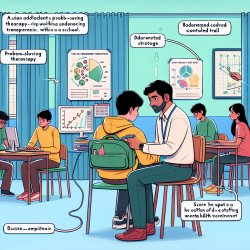Adolescent mental health is a global concern, with anxiety, depression, and conduct disorders accounting for over 75% of the adolescent mental health burden. A recent study titled "The effectiveness of a low-intensity problem-solving intervention for common adolescent mental health problems in New Delhi, India" sheds light on an effective approach to addressing these issues in school settings. This blog will explore how practitioners can leverage the outcomes of this research to improve their skills and encourage further research.
Understanding the Research
The study conducted a two-arm, individually randomized controlled trial in six government-run secondary schools in New Delhi. The targeted sample was 240 adolescents in grades 9–12 who exhibited persistent, elevated mental health symptoms. Participants received either a brief problem-solving intervention delivered by lay counsellors or enhanced usual care with problem-solving booklets. Outcomes were assessed at 6 and 12 weeks post-randomization.
Key Findings
The research revealed several critical findings:
- Adolescents who received the problem-solving intervention showed significant improvements in mental health symptoms and idiographic problems compared to the control group.
- Secondary outcomes such as perceived stress, mental wellbeing, and clinical remission also showed marked improvements in the intervention group.
- The embedded recruitment trial demonstrated that classroom-based sensitization significantly increased referral rates for counselling services.
Implementing the Findings in Practice
Practitioners can enhance their interventions by integrating the following strategies derived from the research:
- Problem-Solving Techniques: Adopt structured problem-solving strategies involving identification, option generation, and implementation. These techniques can be easily taught to adolescents and can be highly effective in reducing mental health symptoms.
- Lay Counsellors: Utilize lay counsellors for delivering low-intensity interventions. This approach is cost-effective and scalable, making it feasible for low-resource settings.
- Classroom Sensitization: Implement classroom-based sensitization sessions to increase awareness and demand for mental health services. This can lead to higher referral rates and early identification of mental health issues.
Encouraging Further Research
While the study provides valuable insights, further research is necessary to optimize and scale these interventions. Areas for future research include:
- Long-Term Outcomes: Investigate the long-term sustainability of the intervention's effects on adolescent mental health.
- Cross-Cultural Applicability: Examine the intervention's effectiveness in different cultural and socio-economic contexts.
- Enhanced Interventions: Explore combining problem-solving techniques with other therapeutic approaches for a more comprehensive intervention model.
To read the original research paper, please follow this link: The effectiveness of a low-intensity problem-solving intervention for common adolescent mental health problems in New Delhi, India: protocol for a school-based, individually randomized controlled trial with an embedded stepped-wedge, cluster randomized c










